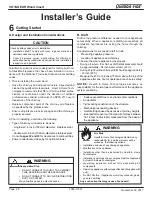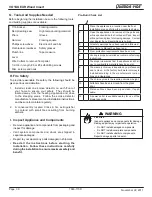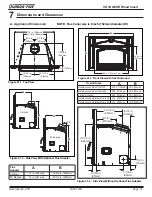
Page 18
7063-173D
November 22, 2011
R
VOYAGEUR Wood Insert
•
Frequency:
When ash reaches the top of the brick
covers (should not spill over covers). Leave 1/4 inch
(6mm) of ash in the bottom of the firebox.
•
By:
Homeowner
A. Disposal of Ashes
• Place ashes in a metal container with a tight-fi tting lid.
• The closed container should be placed on a noncombustible
fl oor or on the ground, well away from all combustible
materials, pending fi nal disposal.
• If the ashes are disposed of by burial in soil or otherwise
locally dispersed, they should be retained in the closed
container until all cinders have thoroughly cooled
WARNING! Risk of Fire!
Ashes could contain hot embers.
3
Maintenance and Service
B. Chimney and Chimney Connector
Inspection/Cleaning
•
Frequency:
Every 2 months during heating season or
as recommended by a certifi ed chimney sweep; more
frequently if chimney exceeds or is under 14-16 feet (4.3
to 4.8m) measured from bottom of appliance.
•
By:
Certifi ed chimney sweep
• Remove all ash from the fi rebox and extinguish all hot
embers before disposal.
• Allow the appliance to cool completely.
•
If your type of installation involves a full reline of the
chimney, it will be necessary to either remove the baffl e
from the insert, or remove the insert from the fi replace
and disconnect the vent prior to cleaning the chimney.
Refer to
page 22
in this manual for instructions on Baffl e
Removal.
•
If your type of installation is direct connect within a masonry
chimney, the insert will need to be pulled out from the
fi replace and disconnected from the fl ue prior to cleaning
the chimney.
• The creosote or soot should be removed with a brush
specifi cally designed for the type of chimney in use.
• Clean out fallen ashes from the fi rebox.
• It is also recommended that before each heating season
the entire system be professionally inspected, cleaned
and repaired if necessary.
WARNING! Risk of Fire!
Do not use chimney cleaners or fl ame colorants in your
appliance. It will corrode your pipe.
Creosote - Formation and Need for Removal
•
When wood is burned slowly, it produces tar and other
organic vapors, which combine with expelled moisture
to form creosote.
•
The creosote vapors condense in the relatively cool
chimney fl ue of a slow-burning fi re.
•
As a result, creosote residue accumulates on the fl ue
lining. When ignited this creosote makes an extremely
hot fi re.
•
The chimney and chimney connector shall be inspected
every two months during the heating season to determine
when a creosote buildup has occurred.
•
When creosote has accumulated it shall be removed to
reduce the risk of a chimney fi re.
C. Appliance Inspection - Routine
• Frequency:
Every 2 months at the same time the chim-
ney and chimney connector are inspected.
• By:
Homeowner
Check for:
• Cracks in glass
• Door handle - smooth cam operation
• Baffl e and ceramic blanket correct placement
•
Baffl e for warpage
• Firebrick for cracks, broken or crumbly
• Door gasket. (Dollar bill test). Place a dollar bill between
the stove and the door and then shut the door. If you can
pull the dollar bill out, replace the door gasket.
• Glass frame for loose screws
D. Cleaning Plated Surfaces
•
Frequency:
As desired
•
By:
Homeowner
• Clean all the fi ngerprints and oils from plated surfaces
BEFORE
fi ring the appliance for the fi rst time.
• If not cleaned properly before lighting your fi rst fi re, the
oils can cause permanent markings on the plating.
• After the plating is cured, the oils will not affect the fi nish
and little maintenance is required.
•
Wipe clean as needed.
CAUTION! Do not use polishes with abrasives.
It will
scratch plated surfaces.
















































